Probing gene-environment interactions in the pathogenesis of Multiple Sclerosis using UK Biobank
Abstract
Background:
The pathogenesis of Multiple Sclerosis (MS) involves genetic and environmental risk factors, but collectively, known risk factors account for a small fraction of MS susceptibility. Understanding gene-environment interactions - whereby the effect of environmental risk factors on MS risk may depend on an individual’s genotype - may help to explain this missing risk, improve predictive algorithms, and shed light on potentially druggable
pathways to disease.
Methods:
We conducted a retrospective case-control study in UK Biobank using 2151 ICD-coded MS cases and 486,125 unmatched controls. Environmental risk factors were tested for associated with MS using multivariable logistic regression. Polygenic risk scores (PRS) for MS were created using weights derived from the IMSGC meta-analysis. PRS performance was optimised in a test set (30% of the cohort) and validated in the remaining 70%. Interaction between environmental factors and the PRS was quantified using the Attributable Proportion due to interaction (AP). Genome-wide interaction studies were conducted using multiplicative interaction models.
Results:
Environmental exposures associated with MS were increased childhood body size, smoking, and earlier menarche. The autosomal PRS was strongly associated with MS disease status. There was evidence of positive (synergistic) interaction between elevated childhood body size and the PRS, and weaker evidence suggesting a possible interaction between smoking status prior to age 20 and the PRS. A genome-wide interaction scan did not show strong evidence of interaction between childhood body size and individual SNPs at genome-wide significance.
Conclusions:
This study provides novel evidence for an interaction between childhood obesity and a high burden of autosomal genetic risk. These findings have significant implications for our understanding of MS biology, and inform targeted planning of prevention strategies. Further efforts are required to discover specific variants and genes involved in modifying the effect of childhood obesity.

